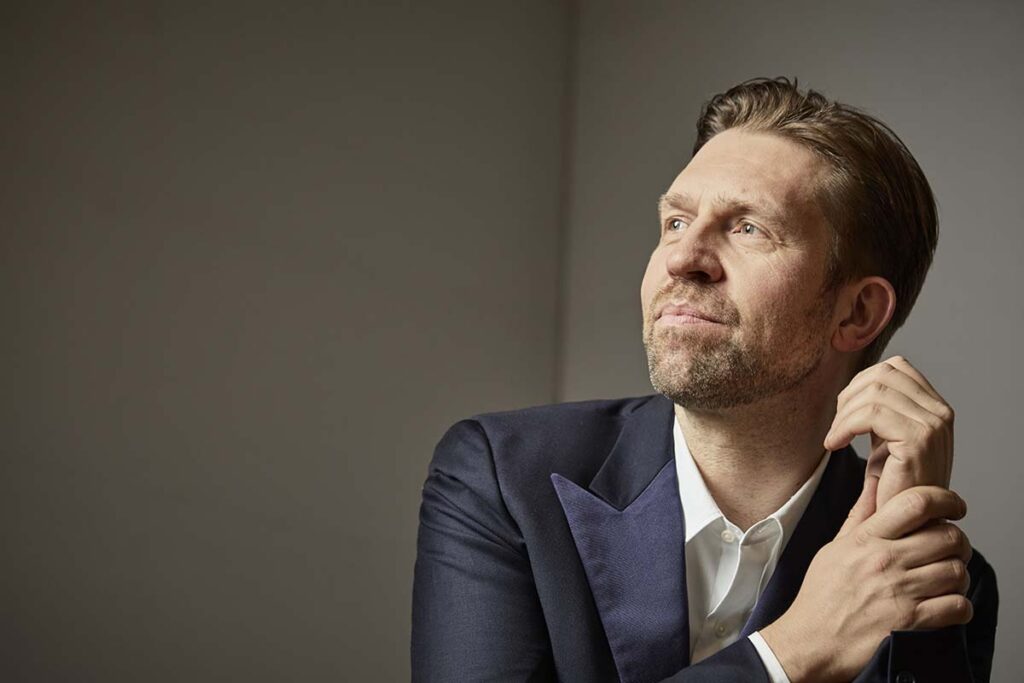Andsnes returns for stellar Beethoven with New World Symphony

Leif Ove Andsnes performed Beethoven’s Piano Concerto No. 5 with Andrew Grams conducting the New World Symphony Saturday night. Photo: Gregory Hohenberg
Leif Ove Andsnes is one of the most intelligent and sensitive pianists on the concert stage. His performances of Beethoven concertos have been particularly distinguished.
The Norwegian pianist returned to the New World Symphony on Saturday night and delivered an electrifying reading of the Concerto No. 5 in E-flat Major (“Emperor”) at the New World Center in Miami Beach. The program was conducted by Andrew Grams, substituting for the ailing Michael Tilson Thomas (who has been advised by his doctors not to travel).
Andsnes tackled the opening cadenza at a fierce clip, with note-perfect runs. Grams led a fleet orchestral tutti and Andsnes continued the strong sense of rhythmic propulsion. His svelte touch and natural feeling for pulse imbued the secondary subject with a romantic spirit. Throughout the initial Allegro, his dynamic range was wonderfully varied from the softest tones to volleys of pianistic thunder.
Grams’ initial tempo in the Adagio tended toward the sluggish but that was quickly corrected once Andsnes entered. The pianist’s exquisite shaping of the melodic line nicely mixed classical restraint with Chopinesque feeling Soft passages registered in an exceptionally beautiful manner. The pianist’s headlong rush into the concluding Rondo proved, for once, jarring as intended and exhilarating. Andsnes and Grams captured the movement’s Viennese dance spirit with virtuosity and charm. Orchestral support was urgent, with well-coordinated ensemble.
Cheers from a capacity audience that immediately lept to its feet at the concerto’s final chord brought Andsnes back for a powerful performance of Brahms’ Capriccio No. 1 in F-sharp minor. His sound at the outset was almost orchestral in scale, balanced deftly by a relaxed and spacious shaping of the contrasting theme.
That encore appropriately set the stage for Arnold Schoenberg’s orchestration of Brahms’ Piano Quartet No. 1 in G minor. Grams strongly emphasized the large-scale wind and brass writing in the first movement and the strings managed to conjure up the quintessential dark Brahmsian sonority. Oboes and strings gave dominant lightness to the Intermezzo. The long melody of the Andante con moto was given weight and space with the corporate orchestral textures well balanced.
Grams fired up the Magyar rhythms of the finale. Schoenberg utilizes such instruments as xylophone, cymbals and tambourine which were definitely not part of Brahms’ compositional palette. When Tilson Thomas led this orchestration at the Lincoln Theater, the ensemble’s former home, the hall’s harsh, blatant acoustic made that instrumentation sound crude and unpleasant. In the superb New World Center, however, Schoenberg’s arrangement glowed, the unusual percussion instruments blending well with the more standard forces. The clarinets’ slides were executed with precision and zest and the violins sounded like a Hungarian café band in the languorous central section.
The concert opened with Shango Memory by Olly Wilson (1937-2018). Inspired by Shango, the Yourban deity of thunder and lightning, the work opens with thunderous percussion blasts and short brass motifs. The eight-minute work contains a hint of jazz, keyboard and harp (placed at far stage right) providing an insistent thumping pattern against the full instrumental contingent. An overture in everything but name, Wilson’s score provided a festive opener, allowing all sections to resound at top volume.
Stèphane Denève conducts Mozart’s Serenade No. 10 (“Gran Partita”), Molly Turner conducts Olly Wilson’s A City Called Heaven and members of the New World Symphony play Enescu’s Piano Quartet No. 2, 2 p.m. October 8 at New World Center in Miami Beach. nws.edu
Posted in Performances
Leave a Comment
Sun Oct 1, 2023
at 12:50 pm
No Comments





